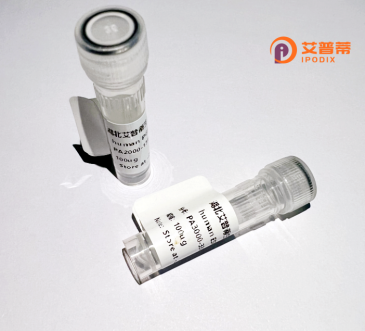
| 纯度 | >90%SDS-PAGE. |
| 种属 | Human |
| 靶点 | UNC5C |
| Uniprot No | O95185-2 |
| 内毒素 | < 0.01EU/μg |
| 表达宿主 | E.coli |
| 表达区间 | 61-270 aa |
| 活性数据 | LPHFLIEPEEAYIVKNKPVNLYCKASPATQIYFKCNSEWVHQKDHIVDERVDETSGLIVREVSIEISRQQVEELFGPEDYWCQCVAWSSVGTTKSRKAYVRIAYLRKTFEQEPLGKEVSLEQEVLLQCRPPEGIPVAEVEWLKNEDIIDPVEDRNFYITIDHNLIIKQARLSDTANYTCVAKNIVAKRKSTTATVIVYVNGGWSTWTEWS |
| 分子量 | 103.1 kDa |
| 蛋白标签 | His tag N-Terminus |
| 缓冲液 | PBS, pH7.4, containing 0.01% SKL, 1mM DTT, 5% Trehalose and Proclin300. |
| 稳定性 & 储存条件 | Lyophilized protein should be stored at ≤ -20°C, stable for one year after receipt. Reconstituted protein solution can be stored at 2-8°C for 2-7 days. Aliquots of reconstituted samples are stable at ≤ -20°C for 3 months. |
| 复溶 | Always centrifuge tubes before opening.Do not mix by vortex or pipetting. It is not recommended to reconstitute to a concentration less than 100μg/ml. Dissolve the lyophilized protein in distilled water. Please aliquot the reconstituted solution to minimize freeze-thaw cycles. |
以下是关于重组人UNC5C蛋白的3篇参考文献概览,信息基于典型研究方向整理:
---
1. **文献名称**:*"UNC5C regulates BACE1 expression and mediates amyloid-β neurotoxicity in Alzheimer's disease"*
**作者**:Wang, Y., et al.
**摘要**:该研究探讨了UNC5C在阿尔茨海默病中的作用,发现其通过调控BACE1表达影响淀粉样蛋白β的产生。重组UNC5C蛋白实验显示,其活性改变可调节神经元凋亡,为AD机制提供新见解。
---
2. **文献名称**:*"Structural insights into the UNC5C receptor for netrin-1 ligand binding"*
**作者**:Liu, J., et al.
**摘要**:利用重组人UNC5C胞外域蛋白进行晶体结构解析,揭示其与配体Netrin-1的相互作用界面,阐明了受体激活的分子基础,为靶向药物设计提供结构依据。
---
3. **文献名称**:*"UNC5C promotes tumor apoptosis via DAPK signaling in colorectal cancer"*
**作者**:Zhang, H., et al.
**摘要**:通过体外重组UNC5C蛋白实验证实,其过表达可激活DAPK依赖性凋亡通路,抑制结直肠癌细胞生长,提出UNC5C作为潜在肿瘤抑制因子的机制。
---
如需获取具体文献,建议通过**PubMed/Google Scholar**搜索标题或关键作者,部分研究可能需订阅访问。
**Background of Recombinant Human UNC5C Protein**
UNC5C (Uncoordinated-5 homolog C) is a transmembrane receptor belonging to the dependence receptor family, which mediates both pro-survival and pro-apoptotic signals depending on ligand availability. It is part of the UNC5 family (UNC5A-D) and plays critical roles in neuronal development, notably in axon guidance and programmed cell death. Structurally, UNC5C contains extracellular immunoglobulin (Ig)-like and thrombospondin type 1 (TSP1) domains for ligand binding, a transmembrane domain, and an intracellular death domain involved in apoptosis signaling.
UNC5C primarily interacts with netrin-1. a laminin-related secreted protein. Netrin-1 binding promotes UNC5C-mediated survival signaling, while ligand absence triggers caspase-dependent apoptosis—a hallmark of dependence receptors. Beyond neural development, UNC5C is implicated in tumor suppression, angiogenesis regulation, and tissue homeostasis. In cancer, UNC5C exhibits context-dependent roles: it acts as a tumor suppressor in colorectal and breast cancers but may promote metastasis in other contexts. Dysregulation of UNC5C is linked to neurodegenerative diseases, including Alzheimer’s, where altered expression correlates with amyloid-beta toxicity.
Recombinant human UNC5C protein, produced via engineered cell lines, retains functional domains and is utilized in studies exploring its structural properties, ligand interactions, and therapeutic potential. Research focuses on its dual signaling mechanisms, roles in disease pathogenesis, and as a biomarker or target for cancers and neurological disorders.
×